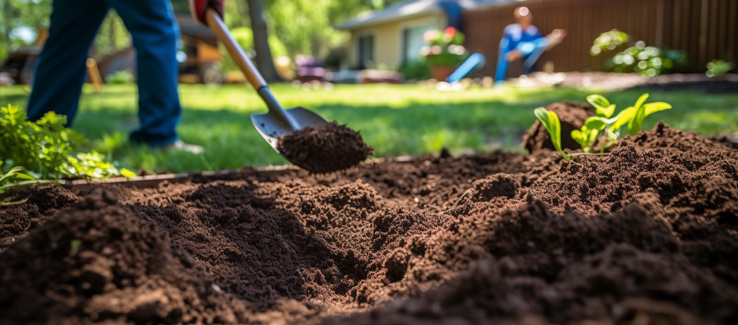How to Level the Ground After Tree Removal
A well-maintained landscape can significantly enhance the appearance of your property, increase its value, and provide a sense of tranquility. But what happens when you need to learn how to level ground after tree removal and stump grinding? The process may seem daunting, but fear not! In this article, we will walk you through the ways to transform your yard into a beautiful, level landscape using the knowledge of how to level ground after tree removal.
Leveling Ground After Tree Removal Short Summary
- Assess the site before deciding on actions to take with the existing lawn.
- Clear debris, test and amend the soil, and fill in holes with topsoil and organic material for successful planting.
- Plant grass seed/sod and maintain the leveled area, or use it for other features such as a garden to enhance your outdoor living space.
Assessing the Site
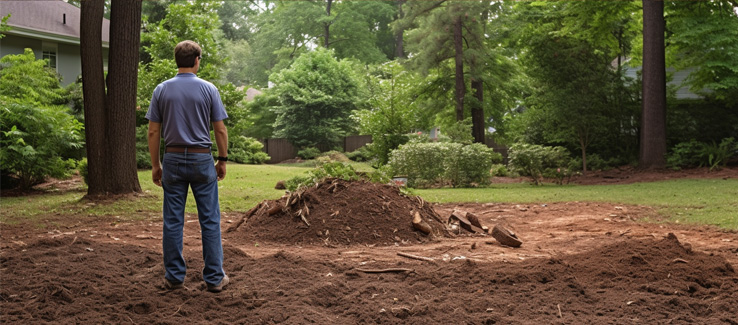
The first step in leveling ground after tree removal is assessing the site. This involves:
- Determining the purpose of the leveled ground
- Identifying any potential hazards or issues
- Removing rocks, wood chips, roots, or any other obstructions that may impede subsequent landscaping.
To assess the condition of the soil, obtain a soil sample. If the soil pH is too low, ground limestone can be added to balance it.
Before deciding on the actions to take with your existing lawn, consider what you want to do with it after tree removal. This may involve:
- Planting grass
- Planting flowers
- Planting a new tree
- Adding a water feature
Clearing Debris and Tree Remnants
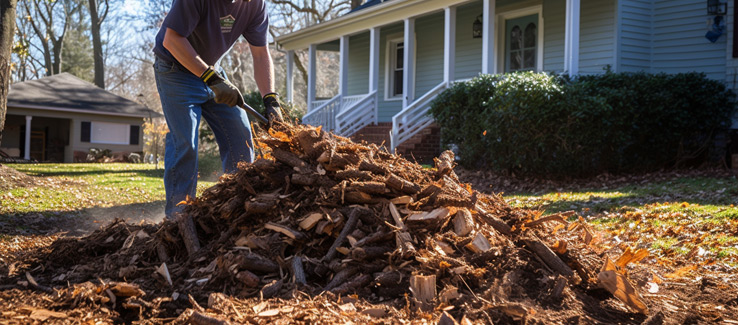
Once the site has been assessed, it’s time to clear debris and tree remnants. This includes tree stump removal and eliminating tree roots and weeds from the area. Stump grinding machines can be used to sever the roots from your lawn and abrade the trunk.
To clear debris, use a pickax, bow rake, and broom rake. After clearing the area, spread wood chips around existing plants and on bare land, maintaining a 2-inch space between the mulch and stems and a 3–4-inch space from the trunks. This will create a clean and healthy environment for new growth.
Soil Testing and Amendment
Before leveling the ground, testing the soil’s pH and nutrient levels is crucial. This will help you determine if amendments are necessary, such as:
- adding limestone to balance the soil’s pH
- adding iron sulfate to balance the soil’s pH
- Replenishing elements like calcium, magnesium, zinc, and phosphates to establish a healthy root system.
Your future plans for the area, including whether to:
- plant grass
- plant flowers
- plant a new tree
- create a walkway
- add a water feature
should be considered when deciding the suitable mineral concentration for the soil. Proper soil amendment will ensure a healthy and thriving landscape.
Filling the Hole with Topsoil and Organic Material
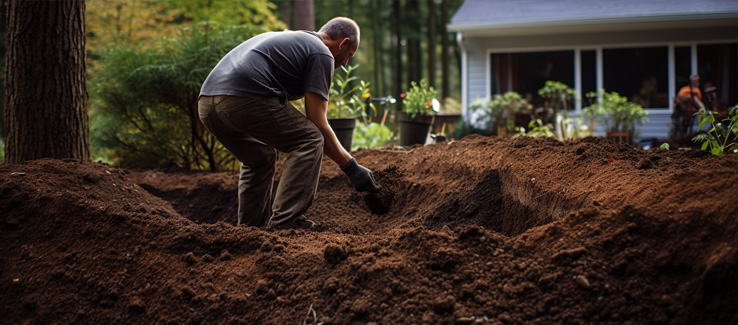
After soil testing and amendment, it’s time to fill the hole left by the tree stump. Mix topsoil and organic materials, such as compost, to fill the cavity. Packing down each layer of the mixture is essential to help the soil settle and create a stable surface.
Nutrient-dense and good-quality topsoil enriched with organic matter, like grass clippings, is recommended for growing new grass. After filling the hole, ensure the landscaping is level and neat by adding more soil as necessary, allowing the ground to settle before proceeding with any further plans. Water the soil with a fine mist to aid in settling, especially when planting grass seed.
Leveling the Ground
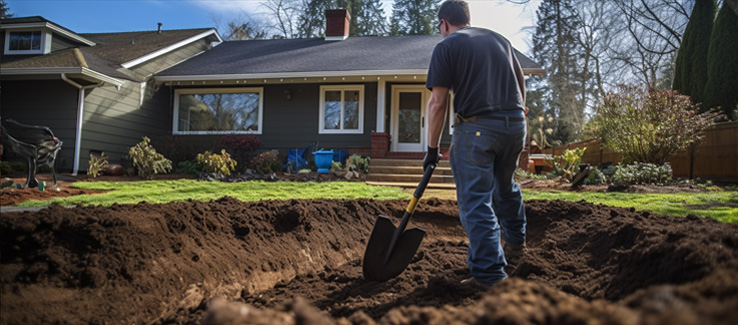
Leveling the ground is an essential step in creating a smooth, even surface that’s ready for planting or other uses. A rake or leveler can be employed to finish the top of the leveled ground, making it ready to sprinkle grass seed. This will help the existing lawn blend seamlessly with the new area.
Avoid over-compacting the soil, as aeration is necessary for the successful establishment of a new root system for grass or plants. It may take a considerable amount of time, even a season, for the lawn to return to its original state and for the soil to settle after tree removal.
Planting Grass Seed or Sod
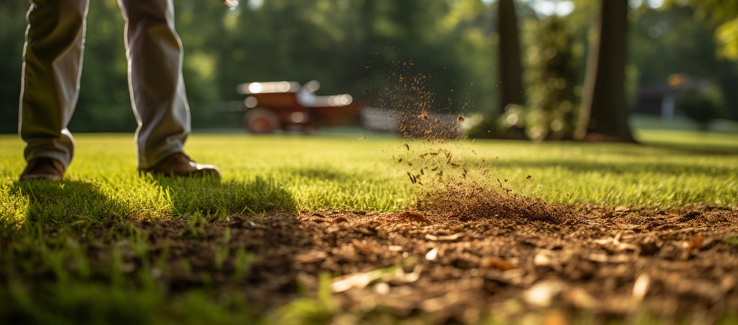
Now that the ground is leveled, it’s time to plant grass seed or lay sod. Here’s how:
- Sprinkle grass seed evenly and crisscross the direction of seeding for optimal results.
- Gently rake the seeds into the soil.
- Apply a layer of topsoil to cover them.
To protect the seeds during germination, cover them with a thin layer of straw. Water the soil thoroughly after planting grass seed or laying sod, ensuring it is kept moist but not soaked to avoid overwatering. This will promote new growth and create a lush, green lawn.
Maintaining the Leveled Area
Maintaining the leveled area is crucial for ensuring a healthy and attractive landscape. Water the site regularly to maintain the existing lawn’s health and promote the growth of new grass. If the new grass has grown to a taller height, mowing the grass is recommended.
Monitor the growth of new grass or plants after planting grass seeds to ensure they are thriving and growing as expected. Proper maintenance will keep your yard looking its best and make it a source of pride for years to come.
Alternative Uses for the Leveled Ground
If you’re looking for alternative uses for the surrounding ground after leveling it, consider constructing a garden feature, installing a deck or patio, or constructing a garden room. Each of these options can enhance your outdoor living space and add value to your property.
To create a garden feature, select plants and shrubs that will thrive in the area and arrange them in a visually pleasing manner. For adding a deck or patio, measure the area, select the materials, and construct the deck or patio. To install a garden room, choose the necessary materials, accurately measure the area, and construct the garden room.
Yard Leveling Summary
In conclusion, leveling ground after tree removal can be a manageable task if you follow the steps outlined in this guide. From assessing the site to maintaining the leveled area, each step is crucial in transforming your yard into a beautiful, level landscape. Whether you plant grass seed, create a garden feature, or install a deck or patio, the result will be a landscape that enhances your property and provides a sense of tranquility.
Frequently Asked Questions
How long does it take for ground to settle after tree removal?
It typically takes a few weeks for the ground to settle after tree removal. The amount of settling will depend on the size of the tree and the type of soil it was growing in, but generally, 1-2 inches of settling can be expected.
This settling can cause problems for homeowners, such as uneven walkways or driveways or even damage to foundations. It is important to wait for the ground to settle to prevent these issues.
How do you level ground after stump grinding?
Remove any wood shavings or dirt chunks from the area, fill the hole with soil, apply nutrient-rich topsoil, and use a rake to level the ground. Once compacted, your surface will be ready for new grass or whatever you want to use it for.
Does ground settle after stump grinding?
Ground will settle once the stump is removed, usually taking weeks. Compacting or tilling the soil can help expedite this process.
How can I ensure my soil is suitable for new growth?
Ensure your soil is suitable for new growth by testing its pH and nutrient levels and adding any necessary amendments like limestone or iron sulfate.
Adding amendments can help balance the pH and nutrient levels of the soil, making it more conducive to new growth.
What can I do with the leveled ground besides planting grass seed?
You can construct a garden feature, install a deck or patio, or build a garden room with the leveled ground in addition to planting grass seed.
(404) 220-9963

